Making a Preparedness Plan - Fire Evacuation
Posted by Ola Griffin on Sep 1st 2023
- People: Ensure the safety of yourself and your loved ones.
- Pets: Don't forget your furry family members.
- Personal Property: Grab essential items like cell phones and computers.
- Prescriptions: Take your necessary medications, both prescription and over-the-counter. CPap machines and other medical devices.
- Papers: Keep an emergency binder with important documents, including property pictures.
- Pictures: Secure cherished family photos (I recommend making digital backups beforehand and having them on external hard drives or in the cloud).
- Plastic: Grab cash, debit cards, banking checkbooks, and credit cards for financial security.
In the past few weeks, the world has witnessed a series of devastating events, from the destructive fire in Lahaina, Maui, Hawaii, to the widespread impact felt across the western US and Canada. Reflecting on the situation in Maui, particularly the response—or lack thereof—to the crisis, my heart is heavy with a mix of sadness and disbelief. The stories of streets rendered impassable, lack of timely alerts, and the absence of immediate assistance paint a grim picture.
The loss of lives and shattered families is heart-wrenching. Imagine people starting their day as usual, unaware of the impending catastrophe that would disrupt their lives forever. Lahaina, once charming, now stands as a stark reminder of life's unpredictability. Some sought safety, while others leaped into the ocean to escape the flames, though tragically not all survived. Amidst the chaos, it wasn't the Coast Guard, but the local Hawaiian community that rushed to help, demonstrating the spirit of Aloha by taking matters into their own hands, offering assistance and supplies to those in need, showcasing a bond that transcends formalities.
I stand humbled by their selflessness and sense of responsibility. I am not a person who expects a handout and/or a hand-up from the government, most people prepping have that same mentality. Witnessing the proactive response of these remarkable Hawaiians has only strengthened my resolve to contribute positively to my community. Just as I've always prepared extra to share with others in times of need, their actions remind me of the profound impact individuals can have when they come together with compassion and determination.
Recent events, like the Maui fire and the lack of timely alerts, bring to mind the recurring wildfires that sweep through California each year, such as the devastating Paradise Fire. It makes me think of how people there sometimes had mere moments to flee, driving through blazing forests. As someone who believes in being prepared, I often imagine scenarios like this. I reside in a mountainside housing community surrounded by juniper trees and pines – a picturesque setting that could turn dangerous in the face of a wildfire. I've mapped out escape routes in my mind, ready to navigate the landscape if the need to escape ever arises due to a forest fire.
A Story of Survival
I recently had a conversation with a customer from Elk in Eastern Washington who bravely shared her story of loss. A few days prior to our conversation, a destructive fire claimed her century-old barn, numerous outbuildings, vehicles, a chicken coop, and neighboring houses. She has given permission for me to share her story.
Late one summer afternoon, on August 25th, just past 4 pm in Elk, Washington, our story unfolds. We find ourselves in this charming rural town, nestled on the husband's ancestral farm that has seen nearly a century of farming history. The property sprawls with acres of land, a barn that's seen a hundred years of weather, various outbuildings, a classic chicken coop, and a few old homes once inhabited by grandparents. Our customers, Sue and Bill (names altered for privacy), were blissfully unaware of the situation they were going to find themselves in.
In the blink of an eye, their tranquil day took a dramatic turn. Sue's phone rang, and a frantic female neighbor, living nearby, urgently warned them of an approaching fire down the road. The call abruptly ended, leaving them with a sense of impending danger. Within moments another woman, a complete stranger, came down their lengthy driveway to notify them that the fire was extremely close. Sue did not know this woman, but in that kind of emergency, she was profoundly grateful for a kind-hearted stranger's act of kindness. There were no official government notifications or texts; the firestorm arrived unannounced.
The fire left a trail of destruction in its wake, claiming two vehicles, the century-old barn, the barn cats, all the outbuildings, the chickens, the coop, the grandmother's home, and so much more. As they watched the flames devour the trees on their land, it was a heavy heart. Fortunately, Sue's and Bill’s house escaped the flames, but not without a fierce battle. It was their unwavering determination that kept their home intact. The protective covers beneath the eaves and the dousing of nearby trees and stumps likely played a crucial role in saving their ancestral home. Their desperate fight exhausted the well's water supply, a testament to the lengths they were willing to go to safeguard their cherished property. In the midst of the chaos, with the relentless fire closing in, they faced a daunting decision: to flee or to stand and fight. Though leaving might have been the safer choice, they bravely chose to stay and do whatever possible to save what they loved.
Had it not been for the caring neighbors and the selfless actions of strangers, they might have found themselves in a deadlier situation, risking the loss of their house and lives.
She said that it happened so fast, leaving her wishing for more time to react. I asked her if she had a grab-go-bag, she said no, but she will now be making one. She mentioned that after the fire she was speaking with her niece who just got rid of her Grab-n-go bags; now both are committed to making new ones. I sent her the link for our blog on the Grab-n-go Bags.
Knowing What to Do if a Wildfire Is Coming Your Way
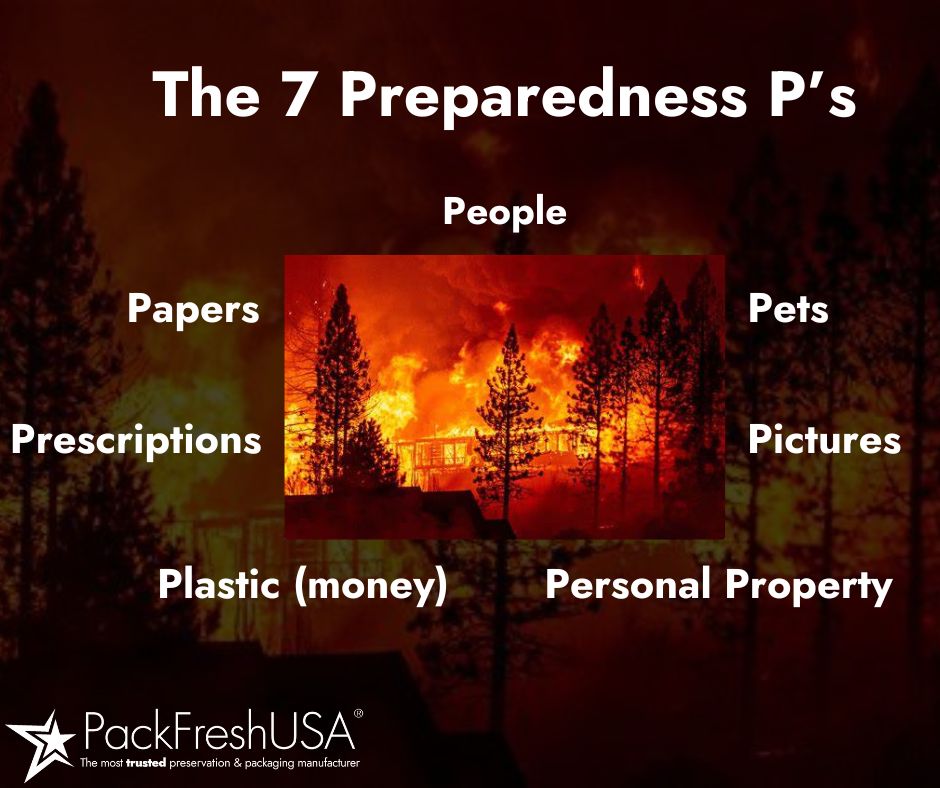
Here are some helpful "P" words to keep in mind when facing the need to evacuate swiftly in the event of a fire, earthquake, hurricane, or any emergency:
The government has devised a 3-level plan for fire evacuation, providing a structured approach to respond to potential threats:
Level 1 - Early Warning: In this initial stage, remain vigilant and be prepared. Keep a watchful eye on developments and start gathering your belongings, just in case.
Level 2 - Be Prepared: At this stage, readiness is key. Have all your essential items packed and ready to go in your vehicle. Position your car facing the street for a swift departure. If you have larger animals, like horses, prioritize their safety by moving them to a secure location. For smaller pets, such as cats and dogs, ensure they are in crates near the door, ready to be grabbed quickly. Remember to have food and water on hand for them.
Level 3 - Immediate Evacuation: If a Level 3 alert is issued, do not delay. Your life is at significant risk, and immediate evacuation is imperative.
When planning your evacuation strategy, take into account your unique circumstances and the perceived level of threat. Always heed the advice of local and state government authorities regarding the current threat level. In the case of a Level 3 alert, prioritize your safety and the safety of your loved ones over material possessions. Remember, nothing is more important than preserving life and well-being in such critical situations.
Do you know what steps to take in case of an emergency? Let's break it down into three levels of evacuation plans, each with its own set of priorities. Start with LEVEL 3, as it contains the most crucial items. Next, tackle LEVEL 2, and finally, consider LEVEL 1. To streamline your evacuation efforts, maintain a clipboard with these level checklists handy. This will help you stay focused and well-prepared as you gather your essentials.
Click HERE for printer-friendly PDF version of these checklists
LEVEL 3 - Immediate Evacuation: Get Out Now
If you have a Grab-n-go bag, retrieve it along with the items listed below. Ideally, store your Grab-n-go bag in a convenient location near the front door or any place that's easily accessible. However, only do this if time permits. This process should take no longer than three to five minutes, so prioritize accordingly. If you don't have a Grab-n-go bag, I strongly recommend putting one together. You can find a helpful guide for building a "Get Home" Bag at the following link: GRAB-N-GO BAGS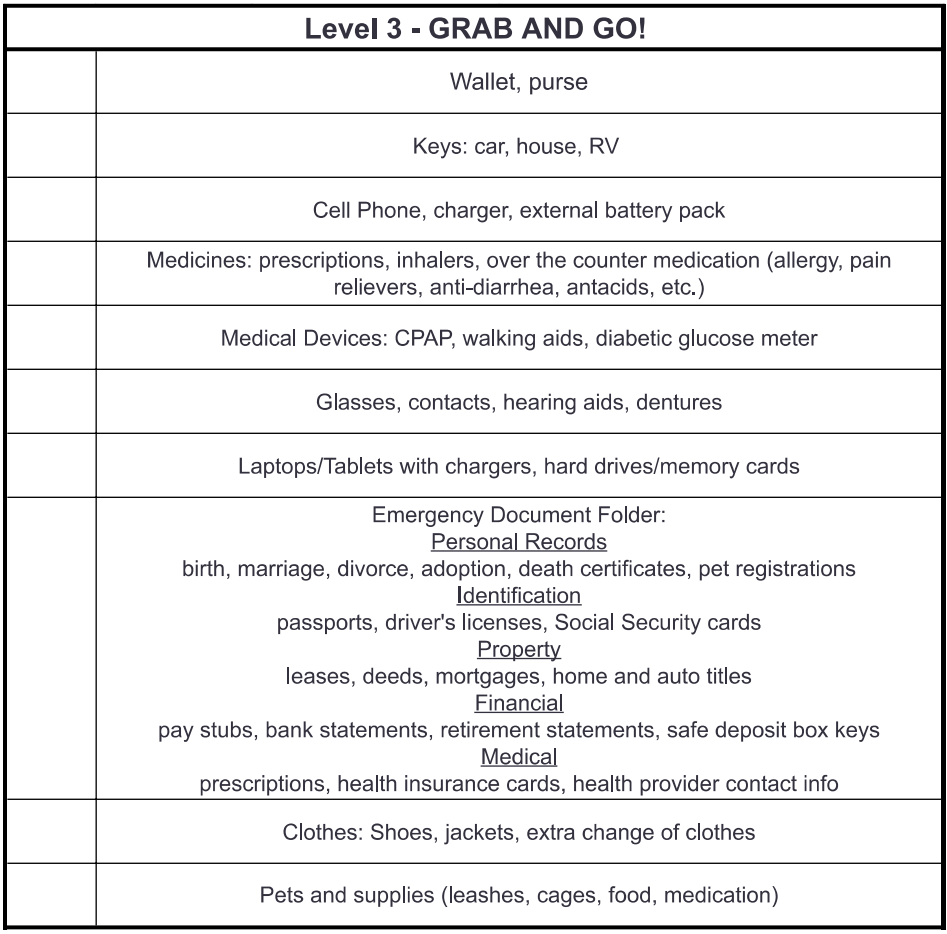
Level 2 - Gather and Be Ready
Be ready to leave at a moments notice. Use a laundry hamper or large basket to gather your items.
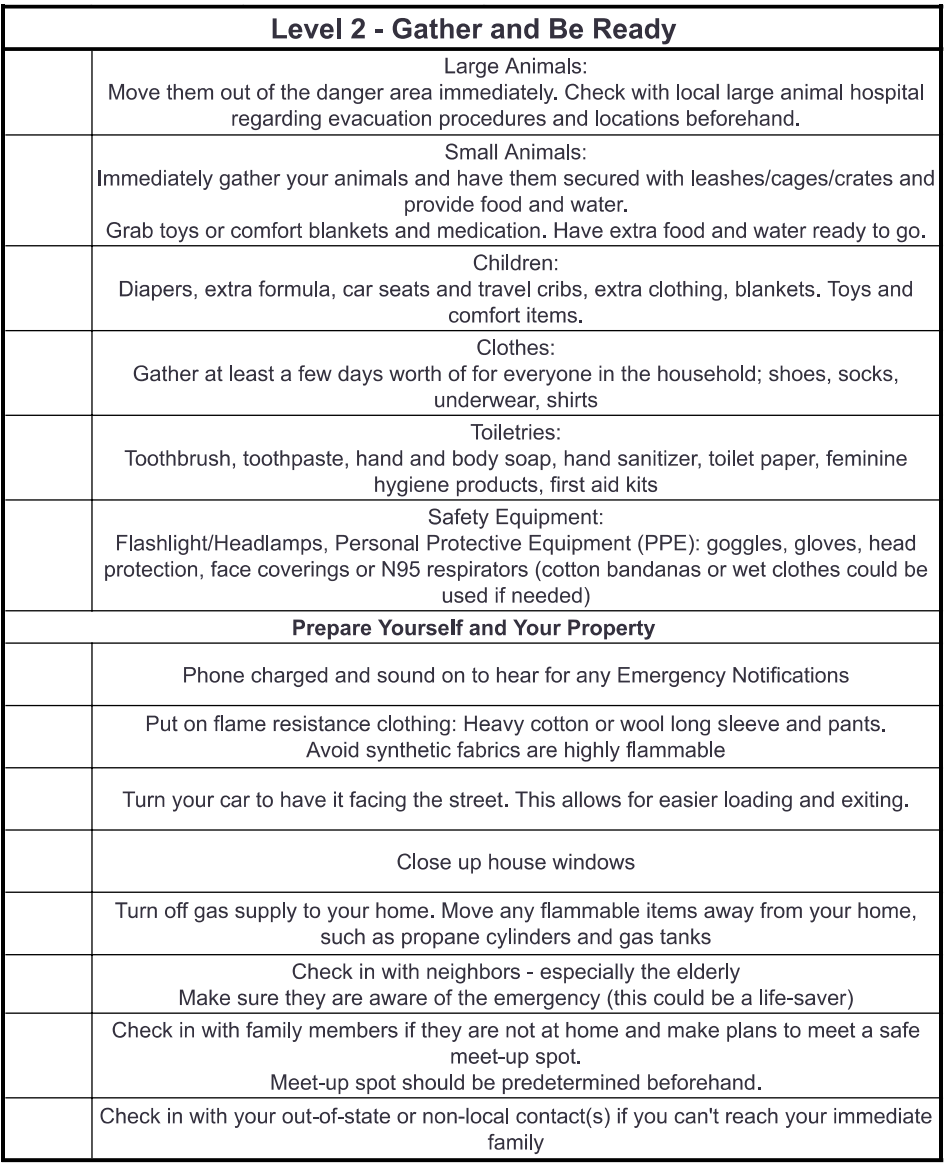 Level 1 - Early Warning - Be Ready - Monitor & Prepare
Level 1 - Early Warning - Be Ready - Monitor & Prepare
According to the US Forest Service, Level 1 is described as an "EVACUATION or PROTECTION ALERT." This indicates the presence of a wildfire threat in your vicinity, prompting the recommendation to start considering preparations such as planning and packing, in case an evacuation becomes required.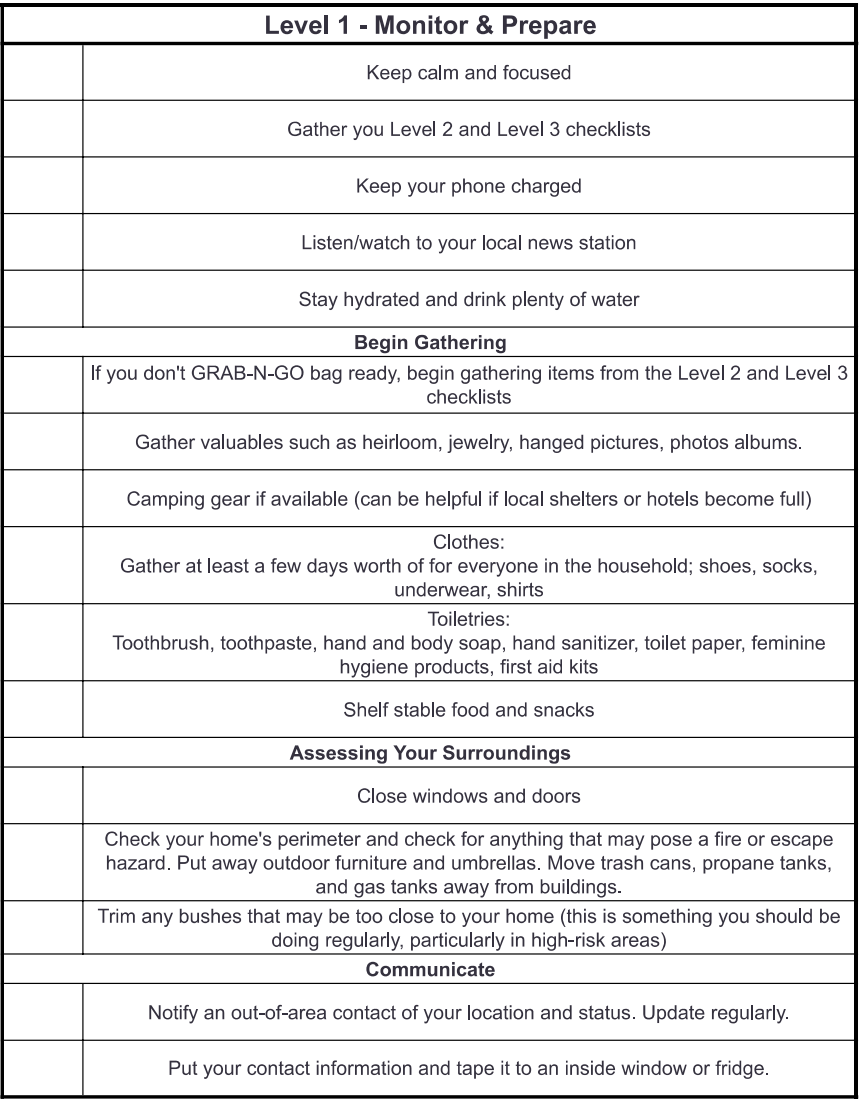
Plan, Prepare, & Share
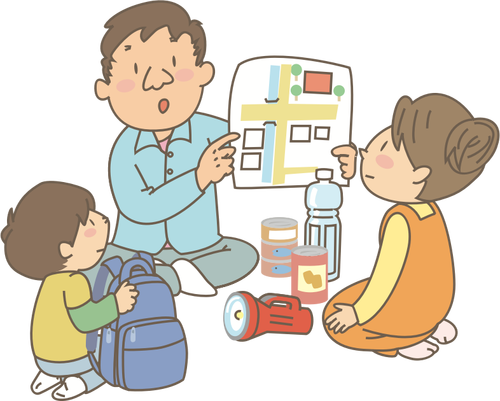
Gather your family together; there's no better time than the present. Take a moment to review fire safety protocols and ensure your smoke and carbon monoxide alarms are in good working order. It's essential to have at least one functioning fire extinguisher on hand, and I recommend having multiple, strategically placed throughout your home. Personally, I have three: one in the garage, another in the kitchen, and the last one in our office building.
This is also an ideal opportunity to discuss fire safety with younger children. You can turn it into an engaging game, teaching them the valuable "STOP/DROP/ROLL" technique.
During your planning meeting, focus on exit strategies in case of a fire. Ensure everyone knows what to do and, just as crucially, what not to do. It's common for children to hide when they're scared, so it's vital they learn the appropriate actions. Practice and planning can truly be lifesavers.
Select an out-of-state contact person and ensure everyone is familiar with their name and number. Include this contact on your children's school emergency cards as well, designating them as the out-of-state emergency contact. Keep a written copy of this number handy in case your cellphone loses power. Instruct everyone to reach out to this contact if they are unable to contact one or both parents.
Designate two meeting spots in different directions. This ensures that, in the event of a fire north of your location, you'll choose the southern meeting point and vice versa. When everyone reaches their designated location, contact the out-of-state contact person and inform them of your whereabouts and which location you're at.
These skills are valuable for teens as well, especially knowing the way from places like school to home.
Above all, the ability to act swiftly and decisively is paramount. This can only be achieved through thoughtful preparation and planning. Humans are creatures of habit, so by practicing, contemplating, and then planning, you'll increase your chances of survival in the face of an emergency.
Stay Informed with Watch Duty
To ensure you are always aware of potential fire hazards in your area, we recommend downloading the "Watch Duty" app. This app provides real-time updates and notifications about fire activity, helping you stay informed and prepared. Click here to download: Watch Duty
Happy prepping and much love,
Ola Dee Griffin
Long-Term Food Storage Expert
Customer Service Dept.
Safeguard Brands, Inc., DBA PackFreshUSA.com
YouTube Creator (14) Pandemic Prepsters - YouTube
Toll Free 5 Star Service Line: (844)8-5STARS (844) 857-827
Cell: (951) 902-4644

